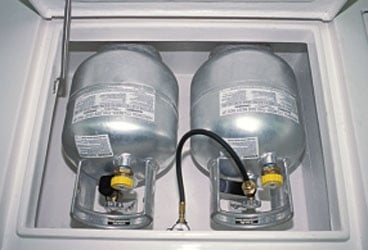
Correctly installed propane tanks
There’s no room for error when it comes to installing, maintaining, and repairing liquid propane gas systems used aboard sailboats. Your routine maintenance checklist should include a thorough look at tanks, hoses, and appliances. If you’re unsure about the safety of the installation aboard your sailboat, seek the expert assistance of a qualified marine technician, preferably someone who’s been certified by the American Boat & Yacht Council.
If you decide instead to inspect your system yourself, begin at the gas tank itself. L.P.G. tanks must be installed either on deck or in a dedicated locker. On-deck gas bottles must be secured for any sea state and should be protected from rain and spray; many have canvas covers. The regulators and valves to each tank must be situated a minimum of 20 inches from any opening into the cabin or a locker. Included in the definition of “opening” are hatches, ports, dorades, solar vents, and essentially any orifice that could allow in L.P.G., which is heavier than air and thus settles into the bilge.
Built-in tank lockers should be located above the static waterline. The lid should open from the top, and the hatch must be gasketed and capable of being securely latched. Ideally, the lid should open directly to the atmosphere; however, if that’s not possible-if, for instance, the L.P.G. locker is located in a lazarette-then its lid should be as close to the hatch opening as possible. The locker’s vent and drain must be installed at the lowest part of the locker; they mustn’t trap water, and the drain must be, again, 20 or more inches from any opening, and it, too, must be located above the static waterline. The locker should be used to stow only gas. Spare tanks must be stored in the same fashion as those being used, which means that they may not be kept in sail lockers, the lazarette, or the cabin.
Each installation should include a pressure gauge, although it isn’t used to determine the quantity of gas remaining in the tank; that pressure remains constant until the tank is virtually empty. Instead, it’s a built-in leak detector. With all appliances off and the remote solenoid, if there is one, open or on, open the L.P.G. tank’s valve for a few seconds. Note the gauge’s pressure, then close the valve. The gauge should maintain pressure for a minimum of 5 minutes. If it drops, there’s a leak, and it needs to be located and repaired.
Lines that carry gas from the locker to each appliance should also be closely inspected. Each stove, heater, or other appliance needs its own continuous line made of either purpose-made flexible gas hose that complies with Underwriters Laboratories standard 21 or annealed type-K or type-L copper tubing with a minimum wall thickness of 0.032 inches. No in-line connections are permitted inside the boat or outside the L.P.G. locker other than where a transition is made between copper tubing and the required length of flexible hose used at a gimbaled stove. Terminations for flexible hose must be permanently swaged or consist of sleeve-and-threaded-insert fittings; don’t use hose clamps. All copper-tubing terminations must use long- rather than short-nut flare fittings; the latter are commonly used on refrigeration systems.
Finally, ensure that the gimbaled mounts for your stove are fully captive. Test this by vigorously pulling up on the stove. If it unships, the mounts are faulty and should be modified or replaced.
From “Hands-On Sailor” in our October 2008 issue. Steve D’Antonio is a regular CW contributor and offers services for vessel owners, boatbuilders, and others in the marine industry through Steve D’Antonio Marine Consulting (www.stevedmarineconsulting.com).








